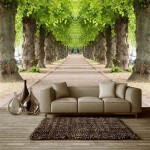How To Decorate a Small Simple Living Room
Decorating a small living room presents unique challenges. Optimizing space, maintaining functionality, and creating an aesthetically pleasing environment require careful consideration. A "less is more" approach is often beneficial, emphasizing simplicity and strategic design choices to maximize the perceived size and comfort of the room.
Effective small living room decoration hinges on understanding the fundamental principles of space management, color theory, and furniture selection. Ignoring these principles can result in a cluttered and cramped space that is neither inviting nor functional. Thoughtful planning ensures the living room is both visually appealing and practical for daily use.
Key Point 1: Maximizing Space with Strategic Furniture Selection
Choosing the right furniture is pivotal in a small living room. Oversized or bulky pieces can quickly overwhelm the space, making it feel smaller than it is. Opting for smaller-scale furniture with clean lines and minimal ornamentation is crucial. Multifunctional furniture, such as a sofa bed or a coffee table with built-in storage, provides practical solutions for saving space and reducing clutter.
Consider the size of the sofa carefully. A sectional sofa, while comfortable, may be too large for a small room. Instead, a compact sofa or loveseat may be more appropriate. Ensure that it fits comfortably in the space without obstructing pathways or dominating the room. Measure the available space accurately before making any furniture purchases to avoid costly mistakes.
Chairs should also be selected with space in mind. Armless chairs or chairs with a narrow profile can provide seating without taking up too much visual space. Transparent acrylic chairs are an excellent option, as they visually disappear and create a sense of openness.
Storage is a critical consideration. Furniture with built-in storage, such as ottomans with hidden compartments or coffee tables with drawers, can help keep the room organized and clutter-free. Vertical storage solutions, such as bookshelves or floating shelves, utilize wall space effectively without encroaching on the floor area.
The placement of furniture is as important as the furniture itself. Avoid pushing all the furniture against the walls, as this can create a boxed-in feeling. Instead, consider floating the sofa slightly away from the wall to create a sense of depth and visual interest. Arrange furniture to promote conversation and interaction, creating a welcoming and functional space.
Mirrors can be strategically placed to create the illusion of more space. A large mirror on a wall can reflect light and visually double the size of the room. Position the mirror to reflect a window or a light source to maximize its effect.
Key Point 2: Utilizing Color and Lighting to Enhance Perception of Space
Color and lighting play a significant role in how a space is perceived. Light and neutral colors tend to make a room feel larger and more open, while dark colors can make a room feel smaller and more enclosed. Opting for a light and airy color palette for the walls, floors, and furniture can significantly enhance the perceived size of a small living room.
Consider using a monochromatic color scheme, using different shades and textures of a single color to create visual interest without overwhelming the space. For example, using various shades of gray or beige can create a sophisticated and cohesive look.
Accents of bolder colors can be incorporated through accessories, such as throw pillows, rugs, and artwork. These pops of color can add personality and visual interest without dominating the space. Limit the number of accent colors to maintain a sense of cohesion and avoid creating a cluttered look.
Natural light is invaluable in a small living room. Maximize the amount of natural light by keeping windows clear and unobstructed. Avoid heavy curtains or blinds that block out natural light. Sheer curtains or light-filtering shades can provide privacy while still allowing natural light to enter the room.
Artificial lighting is equally important, especially in rooms that do not receive ample natural light. Layering different types of lighting, such as ambient lighting, task lighting, and accent lighting, can create a well-lit and inviting space. Ambient lighting, such as recessed lighting or a ceiling fixture, provides overall illumination for the room.
Task lighting, such as a floor lamp or a table lamp, provides focused light for reading or other activities. Accent lighting, such as spotlights or wall sconces, highlights specific features of the room, such as artwork or architectural details.
Avoid using a single overhead light fixture, as this can create harsh shadows and make the room feel smaller. Instead, use a combination of different types of lighting to create a warm and inviting atmosphere.
Key Point 3: Decluttering and Organizing for a Simplified Aesthetic
Clutter is the enemy of a small living room. A cluttered space feels cramped and overwhelming, while a clean and organized space feels open and inviting. Regularly decluttering the living room is essential for maintaining a simple and aesthetically pleasing environment.
Start by removing any items that are not essential or that are not used regularly. Donate, sell, or discard items that no longer serve a purpose. Consider implementing a "one in, one out" rule, where for every new item that enters the room, an old item is removed.
Organize remaining items in a systematic way. Use storage containers, baskets, and bins to keep clutter out of sight. Label storage containers to make it easy to find items when needed. Utilize vertical storage solutions to maximize space and keep items off the floor.
Keep surfaces clear and uncluttered. Avoid piling items on coffee tables, shelves, and other surfaces. A few carefully chosen decorative items can add personality and visual interest without creating a cluttered look. Group items together in small vignettes to create a visually appealing display.
Invest in storage solutions that are both functional and aesthetically pleasing. A stylish storage bench can provide seating and storage in one piece. Floating shelves can display books and decorative items without taking up floor space. Choose storage solutions that complement the overall style of the room.
Consider using a minimalist approach to decorating. Focus on essential items and avoid unnecessary decorations. A few well-chosen pieces of artwork or decorative objects can add personality and visual interest without overwhelming the space. Choose items that are meaningful and that reflect personal style.
Regularly maintain the cleanliness and organization of the living room. A quick daily tidy can prevent clutter from accumulating. Dust and vacuum regularly to keep the space looking fresh and inviting. By maintaining a clean and organized space, the small living room will feel larger, more comfortable, and more enjoyable.
Creating a small, simple living room is about making informed choices that emphasize space, light, and order. By carefully selecting furniture, utilizing color and lighting strategically, and decluttering regularly, any small living room can be transformed into a welcoming and functional space.
:max_bytes(150000):strip_icc()/Neutral-Toned-Living-Room-Via-smallspaces-58aa11135f9b58a3c96eb22f.jpg?strip=all)
15 Simple Small Living Room Ideas For Minimalist Style

51 Inspiring Small Living Rooms Using All Available Space

Living Room Ideas In Small Apartment Settings 10 Simple Tips

15 Simple Small Living Room Ideas B With Style Decoholic

Small Living Room Decorating Ideas For A Stylish Space

Small Living Room Decorating Ideas For A Stylish Space

51 Inspiring Small Living Rooms Using All Available Space

Small Living Room Ideas 3 Easy Design Strategies Spaces

Living Room Furniture Layout Ideas For Small Spaces Beautiful Homes

7 Small Living Room Design Ideas Oppein







